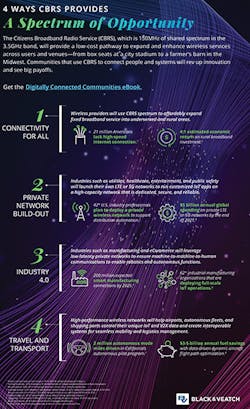Private Broadband Networks
Soon, Reachable for All —
The US is on the cusp of a big change in wireless telecommunications because the Federal Communications Commission (FCC) has made a new band of spectrum available to support wireless broadband applications. Called Citizens Broadband Radio Service (CBRS), this spectrum will be open to municipalities, utilities, campuses, building managers, companies, and more.
CBRS spectrum and its availability could be likened to the introduction of PC operating systems that untethered computing from specific devices and manufacturers’ machines. That computing development launched the PC market and made computers accessible to everyone. Likewise, CBRS will put enormous wireless networking power into the hands of organizations that have never had such a promising and affordable option before. Now is the time to examine CBRS to see if this technology would be a good solution for your networking needs.
Open Air
CBRS Private LTE networks allow users to securely control their unique data and deliver new capabilities on an interoperable, mobile network.
First, the basics: CBRS operates in the 3.5GHz band and uses Long Term Evolution (LTE) standards, the same standards developed to support today’s most advanced mobile networks designed to serve smartphones, tablets, and mobile computing needs.1
The technology will more than meet FCC minimum standard speeds for broadband — 25 Mbps in downloads and 3 Mbps in uploads — so it is a viable alternative for Last Mile fiber in delivering broadband services, particularly in rural settings. Likewise, it’s a promising way to support Internet-of-Things (IoT) applications, and to deliver wireless broadband to venues like stadiums and more.
Why wasn’t CBRS tapped earlier? The usual answer applies here: the FCC needed to develop standards and rules to support opening up this spectrum to a broad array of users and use cases.
This spectrum already had licensed users, especially the Navy, as well as some authorized federal users, grandfathered fixed satellite service earth stations, as well as a few grandfathered wireless broadband licensees in the 3650-3700 MHz portion of the band.2 Although the FCC identified this band as an underutilized resource, there still was one big challenge to overcome: making the spectrum available to commercial users without impeding traffic by its already very important primary user: our nation’s military.
The solution was dynamic spectrum sharing, a newly developed approach that coordinates spectrum access among 3 groups:
Group 1. Incumbent users noted above, who occupy tier 1.
Group 2. Users with priority access licenses (PALs) or tier 2.
Group 3. General authorized users (GAA), which is tier 3.
PAL users might include municipalities that want to offer public wireless broadband in a certain area, such as downtown. Other users could be universities or large enterprises that want campus-wide wireless networking, utilities deploying in-territory networks for smart grid applications, broadband providers needing Last Mile solutions, mobile network operators with capacity constraints, and other organizations for which the license cost makes sense.
GAA users could be building operators trying to shore up poor cell phone reception. Additional possible users include hospitals, stadiums, shopping centers, and other public venues wanting to add broadband service for patrons.
To achieve spectrum sharing among these 3 user levels, each CBRS network will need a Spectrum Access System (SAS), which is a database of CBRS base stations, their location, and the tier status of those stations within the network. The SAS is the traffic director, deciding which transmissions get priority.
To support the SAS in its mission, sensors will be deployed near sensitive incumbent users. A network of radio frequency sensors will provide Environmental Sensing Capability (ESC) to detect usage and alert the SAS to keep radio waves free for the all-important military traffic and other incumbent usage. Using ECS, tier 1 users will be protected from interference.
After incumbent users, PAL users get priority access. PAL operators can purchase licensed spectrum at auction. Each PAL may buy up to four 10 MHz channel licenses on a 3-year term by census tract. PAL licenses will be limited to 7 per census tract, and that leaves as much as 80 MHz available for GAA users, who may use any portion of band not assigned to higher-priority users.3
InvisiLight® Solution for Deploying Fiber
April 2, 2022Go to Market Faster. Speed up Network Deployment
April 2, 2022Episode 10: Fiber Optic Closure Specs Explained…
April 1, 2022Food for Thought from Our 2022 ICT Visionaries
April 1, 2022Advantages of CBRS
There are plenty of advantages to CBRS, one of which is access itself. Here are other benefits:
1. FLEXIBILITY
The FCC’s CBRS rules allow for 2 classes of base stations.
Class A stations have lower power and would more appropriately be used indoors.
Class B stations are designed for outdoor use and could be used for fixed wireless networks.
2. PROPAGATION
The frequency of this spectrum gives good signal propagation. Its deployment architecture is well suited for Last Mile transmission as well as large outdoor networks. In addition, the spectrum access management system improves efficiency of spectrum use — and helps keep costs down — by enabling many devices to operate simultaneously without interference.
3. COST
The CBRS Alliance, an industry-backed advocacy group, produced a detailed white paper outlining cost savings potential for multiple applications. Among the potential money-savers are lower installation costs, license-free operation for GAA users, lack of citing issues because users may own the property in which the broadband is deployed, and lower operating expenses for the same reason: the users have control over the location of the network. CBRS also might eliminate or reduce data backhaul expense.
Given these parameters, researcher Monica Paolini, author of the CBRS cost white paper, concluded in one use-case calculation that a hospital could save 38% with CBRS versus a solution backed by a wireless Internet service provider.4
Each census tract will assign frequency to as many as 7 PALs, and since there are some 74,000 census tracts in the US, Puerto Rico, and American Samoa, according to 2010 census figures, analysts at Mobile Experts expect each PAL spectrum license to be relatively low-cost, according to analysis by Mobile Experts.5
Equipment costs for deploying applications continue to drop. When users can take advantage of component costs that leverage LTE scale, the result is competitively priced CBRS devices for high-speed Internet access and sensor networks.
Ample Possibilities
Given the affordability and potential ease-of-access with CBRS, there are plenty of potential use cases. Some of the more likely ones include:
1. Rural Broadband Providers
Because of its propagation, affordability, and accessibility, CBRS could be a winning Last Mile solution for utilities, municipalities, and other service providers that offer broadband to remote areas. As a case in point, Midco, a provider of high-speed Internet service, recently completed testing on a CBRS market trial at 3 sites in rural Minnesota and North Dakota that covered approximately 1,348 rural residents and businesses. The test verified that base stations and customer premises equipment could successfully communicate, and that the SAS could assign spectrum to support service delivery.6
2. Utilities
Utilities will likely be one of the prime users of this spectrum to support smart-grid applications, such as distribution system automation and deployment of grid-edge sensors. CBRS will allow utilities to deploy a wireless network with licensed spectrum that they can control and manage to ensure security and grid reliability.
3. Private LTE Networks
CBRS can replace Wi-Fi or be used in conjunction with it to support broadband in public venues, such as hotels, stadiums, and business, or educational campuses. It also can address coverage gaps in such facilities, which is a big plus when you consider that analysts at Mobile Experts estimate there are as many as 30 billion square feet of commercial floor space in the US where mobile coverage is poor or non-existent.7 This same group of researchers also forecast the private LTE and 5G market will grow at a 10% CAGR between now and 2024, eventually becoming a $3.4 billion annual market.8 Will common mobile devices be ready for these private LTE networks? Today, most aren’t, but Samsung’s Galaxy S10 and the Google Pixel 3 are already CBRS-ready.9
Application Services Await
Ahead, there is an array of application services waiting to be launched. Some may support business processes. For instance, imagine a shipping port with a private wireless network that allows shippers to more precisely track cargo. A service could deliver a ship’s manifest to stevedores and longshoremen miles before the ship makes port so that they know what’s coming and can have the appropriate cranes, trucks, and other vital equipment, ready for faster unloading.
Here’s another example: in February 2017, Nokia, Alphabet’s Access Group, and Qualcomm Technologies, Inc., joined forces to build a virtual reality zone at the Las Vegas Motor Speedway. With 360° video streaming, the companies provided an "in-car" experience in real time to stock car race watchers. The demonstration showed how venues could deploy their own private LTE network to offer new services.10
With applications like these, there are good reasons CBRS is dubbed "the innovation band." It offers organizations an accessible and powerful wireless alternative capable of supporting IoT applications, private networks, and more.
There have been a few delays in getting CBRS market-ready, but now the Wireless Innovation Forum (WInnForum), a standards body supporting CBRS standards development, sees the technology coming available soon. According to WInnForum, initial commercial development was likely to begin this September, and full commercial service should come online by year-end.11
If you’re not looking at CBRS, now would be a good time to start. It might be the perfect networking solution for your business needs.
Endnotes
1. Network World, FAQ: What in the wireless world is CBRS?, March, 2017. https://www.networkworld.com/article/3180615/faq-what-in-the-wireless-world-is-cbrs.html
2. 3.55 GHz Band / Citizens Broadband Radio Service, FCC website, April, 2019. https://www.fcc.gov/wireless/bureau-divisions/mobility-division/35-ghz-band/35-ghz-band-overview
3. Ibid.
4. The total cost of ownership (TCO) for fixed OnGo in the 3.5 GHz CBRS band, Monica Paolini, Senza Fili, 2018. https://www.cbrsalliance.org/wp-content/uploads/2018/06/The-TCO-of-fixed-OnGo-in-the-3.5-GHz-CBRS-band_Whitepaper.pdf
5. CBRS: New Shared Spectrum Enables Flexible Indoor and, Outdoor Mobile Solutions and New Business Models, Kyung Mun, March, 2017. https://www.federatedwireless.com/wp-content/uploads/2017/09/Mobile-Experts-CBRS-Overview.pdf
6. Midco Completes Successful CBRS Spectrum Access System Trial Testing, press release, April, 2019. https://www.midco.com/news-and-events/2019/4/26/midco-completes-successful-cbrs-sas-trial-testing/
7. Ibid.
8. Mobile Experts Inc. Releases Industry Benchmark Report on Private LTE Global Private LTE & 5G Market to reach $3.4 Billion by 2024, press release, February, 2019. https://www.prnewswire.com/news-releases/mobile-experts-inc-releases-industry-benchmark-report-on-private-lte-300793642.html
9. CBRS 101: What Is It and Why Should You Care?, Day Wireless Blog, April, 2019. https://www.daywireless.com/blog/2019/04/03/cbrs-101-what-is-it-and-why-should-you-care/
10. Nokia, Alphabet’s Access Group and Qualcomm showcase first live demo of a private LTE network over CBRS shared spectrum providing a 360° race car experience, Nokia press release, February, 2017. https://www.nokia.com/about-us/news/releases/2017/02/07/nokia-alphabets-access-group-and-qualcomm-showcase-first-live-demo-of-a-private-lte-network-over-cbrs-shared-spectrum-providing-a-360deg-race-car-experience/
11. CBRS WinnForum, CBRS Status Summary, July, 2019. https://cbrs.wirelessinnovation.org/cbrs-status-summary
Like this Article?
Subscribe to ISE magazine and start receiving your FREE monthly copy today!
Resources
For more information about the CBRS Alliance, please visit https://www.cbrsalliance.org/.
To read more about advanced communications, and to download "Digitally Connected Communities" eBook, please visit https://pages.bv.com/DigitallyConnectedCommunitieseBook.html?utm_source=ise%20magazine&utm_medium=article&utm_campaign=cc%20ebook18&utm_content=cc%20ebook18here.
About the Author







